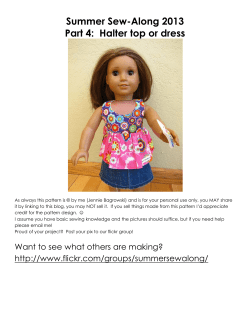
S K I
Secure Kids In Properly Instruction manual manufactured in New Zealand© www.skipharness.com Introduction The Leather used to manufacture the S.K.I.P. Harness is of high strength, durability, comfort and complies with infection control standards. The Leather of the SKIP Harness has a non-absorptive barrier on its surface stopping particles from being absorbed, still allowing at the same time for the leather to breathe. The use of industrial Velcro as the securing mechanism provides ease of assembly and security in the volatile transport environment. S.K.I.P. Incubator Harnesses The S.K.I.P. incubator Harnesses can be used in the transportation of infant’s weighing between 500gms to 5kg. They are designed to be fitted into an incubator system. The S.K.I.P incubator Harness is available in two sizes: Small (pink label) 500gms to 1.5kg. Medium (blue label) 1.5kg to 5kg Instructions for Use in an Incubator Attaching the S.K.I.P. Harness fixing kit to your incubator tray 1. Attach the fixing kit to the inside of the incubator tray with the head of the bolt on the inside of the tray. The end of the bolt on the outside of the tray needs to be filed down once the nut is placed on and tightened to ensure that there is no movement with excessive vibration. Page 1 of 8 2. Place the S.K.I.P Harness in the incubator with the head end to the head of the cot. Pass the securing flaps between the bars and attach the Harness sides around the bar. 3. Secure the ends together, with the Velcro. Adjust the sides so the harness is firmly secure. Securing the Baby into the Harness 4. Open all straps as below Page 2 of 8 5. Place infant in the harness and lay the shoulder and crotch straps in place 6. Fasten the waist strap 7. Pass the shoulder and crotch straps through the loops and secure firmly with the Velcro. You should be able to pass a finger below the straps so do not secure them too tightly Options for the Straps 8. Cross the straps across the baby for little babies Page 3 of 8 S.K.I.P. Cot and Stretcher Bridge Harnesses The S.K.I.P. Cot and Stretcher Harnesses can be used in the transportation of infant’s and toddlers weighing between 1.5kg to 10kg. They are designed to be fitted into a cot or on a stretcher bridge system. Instructions for use when using Stretcher Bridge or Cot Attaching the S.K.I.P. Harness to your Stretcher Bridge 1. Place on the stretcher with the head end towards the head of the stretcher 2. Pass the securing flaps around the side rails of your stretcher and secure with the Velcro Page 4 of 8 Attaching the S.K.I.P. Harness into a modified Perspex Cot 1. Lay the harness open inside the cot with the head end to the head of the cot 2. Pass the securing flaps through the slits in either side of the modified cot 3. Secure the 2 ends together under the cot, with the Velcro Pictures of Paediatric Infants during a Flight Transport Page 5 of 8 Attaching the S.K.I.P. Harness to your Stryker – with Harness Page 6 of 8 Attaching the S.K.I.P. Harness to your Stryker – with Cot Page 7 of 8 Transporting Twins Twins can be transported safely in the same incubator. Their heads must be protected. In this illustration we have used two car seat inserts to cushion each baby’s head. The single, medium S.K.I.P Harness secures both babies. One shoulder strap over each baby, the middle strap secured around the babies hips. Each baby can be individually monitored by a portable oxygen saturation monitor. If you plan to transfer one baby in a cot and one baby in a car seat in the same ambulance you will require an ordinary road ambulance, not the Baby Bus. The cot must be secured on the stretcher on the right side of the ambulance Page 8 of 8
© Copyright 2025














